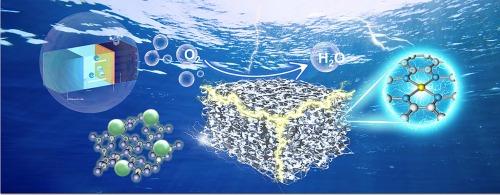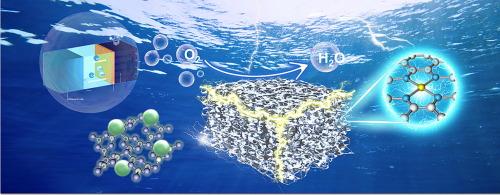Dual templated assisted fabrication of atomically dispersed Fe active sites on nitrogen-doped porous carbon for enhanced oxygen reduction reaction in Zn-air battery
IF 4.3
2区 工程技术
Q2 ENGINEERING, CHEMICAL
引用次数: 0
Abstract
The embedding of iron single atom into nitrogen-doped carbon matrix (Fe-N-C) provides an alternative option to precious metal-based electrocatalysts for oxygen reduction reaction (ORR). Modulating the microenvironment around the central iron atom can substantially prompt the electrocatalytic activity. Herein we demonstrate the fabrication of single atomic iron sites embedded on nitrogen-doped porous carbon (SA-FeNC/NPC) through a dual-template strategy as efficient ORR electrocatalyst. The presence of defect-rich, highly dispersed Fe-N4 active sites, coupled with extensive porosity and excellent conductivity, confer superior ORR performance in alkaline media, achieving a half-wave potential of 0.904 V, significantly surpassing commercial Pt/C electrocatalysts, while exhibiting good methanol tolerance and cycling stability. When applied to Zn-air battery, SA-FeNC/NPC-900 demonstrates a charging and discharging stability up to 120 h. Density functional theory (DFT) calculations reveal that the unique combination of carbon defect around single-iron atom sites, abundant pyridinic nitrogen, and the layered porous architecture significantly enhances the ORR activity.


双模板辅助在氮掺杂多孔碳上制备原子分散铁活性位点以增强氧还原反应
铁原子嵌入氮掺杂碳质基质(Fe-N-C)为氧还原反应(ORR)提供了一种替代贵金属基电催化剂的选择。调节中心铁原子周围的微环境可以显著提高催化活性。在此,我们展示了通过双模板策略在氮掺杂多孔碳(SA-FeNC/NPC)上嵌入单原子铁位点作为高效ORR电催化剂的制备。富含缺陷、高度分散的Fe-N4活性位点的存在,加上广泛的孔隙度和优异的导电性,赋予了碱性介质中优越的ORR性能,实现了0.904 V的半波电位,大大超过了商用Pt/C电催化剂,同时具有良好的甲醇耐受性和循环稳定性。当应用于锌空气电池时,SA-FeNC/NPC-900的充放电稳定性高达120 h。密度泛函理论(DFT)计算表明,单铁原子周围的碳缺陷、丰富的吡啶氮和层状多孔结构的独特组合显著提高了ORR活性。
本文章由计算机程序翻译,如有差异,请以英文原文为准。
求助全文
约1分钟内获得全文
求助全文
来源期刊

Chemical Engineering Science
工程技术-工程:化工
CiteScore
7.50
自引率
8.50%
发文量
1025
审稿时长
50 days
期刊介绍:
Chemical engineering enables the transformation of natural resources and energy into useful products for society. It draws on and applies natural sciences, mathematics and economics, and has developed fundamental engineering science that underpins the discipline.
Chemical Engineering Science (CES) has been publishing papers on the fundamentals of chemical engineering since 1951. CES is the platform where the most significant advances in the discipline have ever since been published. Chemical Engineering Science has accompanied and sustained chemical engineering through its development into the vibrant and broad scientific discipline it is today.
 求助内容:
求助内容: 应助结果提醒方式:
应助结果提醒方式:


